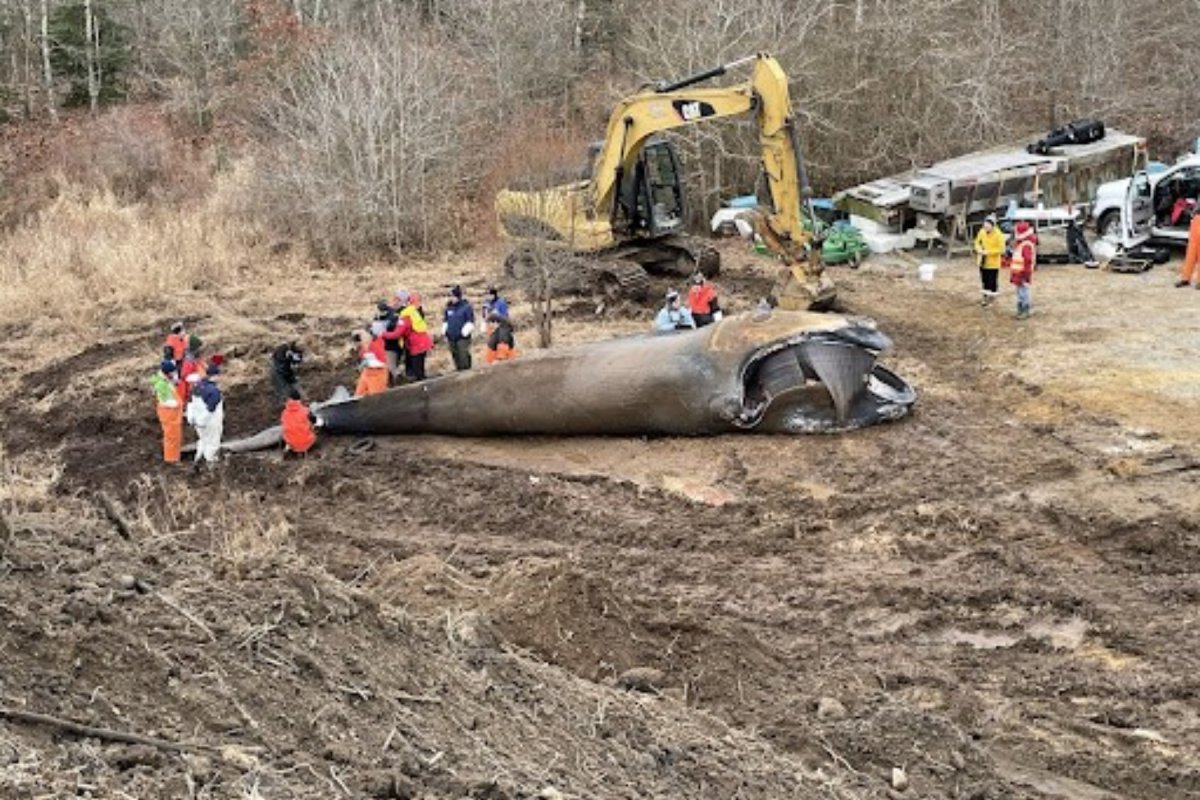The death of an endangered whale that washed up on a beach on Martha’s Vineyard may have been linked to it getting tangled up in fishing gear.
The North Atlantic right whale was discovered on Joseph Sylvia State Beach on January 28, but the reason for its death was uncertain, despite clear injuries from entanglement with ropes. Now, investigators with the National Oceanic and Atmospheric Administration (NOAA) and animal welfare groups have performed a postmortem on the whale, concluding that its entanglement was likely linked to its death.
“From the necropsy, experts confirmed a chronic entanglement, with rope deeply embedded in the tail, and thin body condition. The necropsy showed no evidence of blunt force trauma,” NOAA Fisheries explained in a statement.
Woods Hole Oceanographic Institute/Michael Moore/ NOAA Permit # 24359.
Blunt force trauma would have indicated that the animal had perhaps been hit by a boat, but that does not appear to have been the case.
While the entanglement likely made life difficult for the whale, the exact cause of death is still unconfirmed.
“Cause of death is pending further histological and diagnostic testing of collected samples, which can take weeks to complete,” NOAA said.
The whale was determined to be a three-year-old female North Atlantic right whale that had been previously identified and named as No. 5120. North Atlantic right whales are listed as “endangered” on the IUCN Red List, with as few as 366 individuals left in the world.
Once abundant in the waters of the North Atlantic, these whales have faced relentless pressures from centuries of commercial whaling. Their slow-moving nature, coupled with their tendency to stay close to the coastline, made them easy targets for whalers, pushing their population to the brink of extinction by the early 20th century. Although legal protections and conservation efforts have been implemented since then, the species has struggled to recover.
“North Atlantic right whales are approaching extinction with approximately 360 individuals remaining, including fewer than 70 reproductively active females. The most pressing threats to right whale survival include both entanglement in fishing gear and vessel strikes in U.S. and Canadian waters, which are the leading causes of the ongoing Unusual Mortality Event that has been affecting the species since 2017,” Lauren Gaches from NOAA Fisheries told Newsweek. “Other threats include climate change, which may alter their habitat use patterns and prey availability; and an increasingly noisy ocean, which may affect their ability to communicate, find food, and navigate.”
This species is especially prone to entanglements in fishing gear and other pollution. According to NOAA, several studies have shown that over 85 percent of North Atlantic right whales have been entangled at least once, with 60 percent having been entangled multiple times. Ropes and nets can dig into their skin, leading to injuries, infections and often death.
“Even if gear is shed or removed through disentanglement efforts, the time spent entangled can severely stress a whale, weaken it, prevent it from feeding, and sap the energy it needs to swim, feed, and reproduce. Chronic entanglements are one reason scientists think that female right whales are having fewer calves and are taking longer to have calves,” Gaches said.

Woods Hole Oceanographic Institution/Michael Moore
Whale No. 5120 had been entangled multiple times, including in August 2022 and January 2023. Conservationists attempted to free her from the rope around her tail several times to no avail, and by June last year, her condition was seen to be getting worse and worse, with her wounds deepening.
“She was trying her best to be a right whale,” Scott Landry, head of the disentanglement team at the Center for Coastal Studies (CCS) in Provincetown, told Cape and Islands. “But she was getting thin. Her body was more covered with whale lice. Her skin was starting to deteriorate. These are signals that this is a whale that is going downhill. And then, after that, she was found dead on Martha’s Vineyard.”
Whale No. 5120 was removed from the beach by the necropsy team, as she was too close to the sea to perform the necropsy properly. Her body was taken to forestland belonging to the Aquinnah Wampanoag Tribe, where the necropsy was performed on February 1. Her body was then buried in the forest.

OAA Fisheries / NOAA Fisheries Permit #24539
The rope that entangled her is also being investigated.
“State law enforcement officials collected some of the rope and turned it over to NOAA’s Office Law Enforcement. It is now being examined by gear experts,” NOAA said.
The samples collected from her body will hopefully reveal the final cause of death.
Do you have a tip on a science story that Newsweek should be covering? Do you have a question about the Great Lakes? Let us know via [email protected].
Uncommon Knowledge
Newsweek is committed to challenging conventional wisdom and finding connections in the search for common ground.
Newsweek is committed to challenging conventional wisdom and finding connections in the search for common ground.


